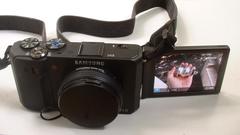
| [ Main index » Bicycle components tests » (Dynamo) bicycle lighting » Camera stuff » Camera comparisons | ] |
I wasn't much interested in cameras before I started making beamshots. Before that time I had a Fuji 2600z from 2001 that I used for everything and it's good enough for pictures for my website and for holiday pictures it seemed good enough too. But for beamshots it's useless, as it doesn't have a fully manual mode.
In Autumn 2010 when I started to expand my bike light page (it was still a single page...) I bought a Samsung ST70 which is small, and was fairly cheap but still offered a nightmode with enough settings to make proper beamshots. For that purpose it worked well, but I wanted to experiment with full manual settings, e.g. white balance, so I dived into the subject of cameras.
I didn't want a DSLR because they were too expensive and too big and then you need to think about lenses etc. So I wanted an 'enthusiast compact'.
In May 2011 I bought a Samsung EX1 which is the camera I used for videos as well as beamshots. In retrospect I am happy with this choice, also to experience an articulated screen.
I kept up with developments in cameras as I still wanted a better camera than the EX1, especially as its videos are weak, but I suspect all cameras with smallish sensor have such a weakness. My considerations of what to choose haven't changed much since I had enough experience with the EX1 to know what I wanted next: A DSLR is better but big and I'd need to think about buying lenses etc. March 2013 I intended to finally buy a new camera and my view was even more in favour of an enthusiast compact: Taking a DSLR such as the Nikon D5100 with its kit lens, gives no advantage over say a Sony RX100 compact camera due to the aperture difference (F3.5 vs F1.8, when not zooming in). To get ahead with the D5100 and all cameras with changeable lenses, you need a prime such as 28mm F1.8 which are usually expensive (and larger aperture lenses are far more expensive). Only then will you get much better light gathering ability than with the best compact cameras. The RX100 is about the best compact camera at the moment, at a slightly lower level are Fuji's X20/X10, Nikon's new P330 and the older Nikon P7700, Olympus XZ-2. Price-wise such high end compacts are not much cheaper than a D5100 with a cheap prime, but for me a RX100 would be better in more respects, e.g. it's light weight which is good for on holidays (for biking and hiking trips).
In April 2013 I bought a RX100, and my comparison of the RX100 vs. EX1 is in progress, pictures to follow, along with videos of bicycle lamps in action.
I wanted better nighttime movies than the EX1 can make, and the best thing would be to use 2 cameras, a DSLR (say the Nikon D5100 or Canon EOS 600D) for beamshots and nighttime video, and a smaller compact camera for daily use, but I didn't want to spend that much on cameras in 2011-2012. And in 2013 it seemed system cameras don't add much over the RX100, so I bought that as the successor to the EX1 for images but especially video on my site.
After using the RX100 for a while, I find image quality to not be as exceptional as made out in many reviews, though it is better than the EX1, in most cases. There are cases where, in JPEG at least, the EX1 does a better job of preserving the texture of say wood. I've seen a similar effect in some comparison pictures where details were gone from the RX100 pictures.
But with the RX100 sensitivity (ISO) can be raised in darker situations and it affects the image quality far less than with the EX1 and if you downsample the RX100 images to the same resolution as in the EX1, the image will be much better than the EX1's image. Still, I would like to see non-blurry noise free ISO 800 full resolution images and I don't see that.
Another issue, possibly causing the loss of some textures, is that dark areas are too dark on the RX100...
I don't miss the articulated screen of the EX1 so far, but more on this further on.
Weight of the EX1 with battery and memory card is 338 g. The RX100 with battery and memory card weighs 241 g. The RX100 doesn't feel light, this is quite different from say the Samsung ST70 that I used for a while to make beamshots (for which it works quite well, except there's no full manual mode, esp. no white balance setting in night time mode which one needs to use to make pictures with specific aperture/exposure time/ISO). The ST70 weighs ca. 110g and that's light and small and easily put into a coat pocket. The RX100 not so much. I consider it too heavy (coat sags on one side) and too big for that. Still, I knew that, I felt the same with the WB2000 that almost weighs as much as the RX100. I used the WB2000 briefly for testing as I described earlier.
The EX1 and RX100 are sturdy and heavyish feeling metal boxes. Metal is fine, but cold to the hands... The Nikon P330 that I tried feels much lighter though it's around 200g, not that much lighter than the RX100 but significant nevertheless. It also has a better grip, which even though it looks insubstantial is still enough to make it unlikely to slip out of your hands. With the RX100 this can be an issue. I found it OK so far, but a more grippy surface or finger grip on front would have improved this aspect of the camera a lot.
After using the RX100 for a while, the EX1 seems big and heavy, clunky even... It also feels very slow especially because of the slow autofocus. The menu system on the RX100 is also better.
Handling of the RX100 even without reading the manual is good, the focus is fast, much much faster than the EX1. Focussing speed is probably the biggest weakness of the EX1. I have to consciouly keep the EX1 very still and wait for it to complete the focussing/clicking/picture-made cycle, when making pictures of anything. On a trip in August 2012 when I wanted to make pictures while in a riding car, this lost me lots of shots of sites and buildings I tried to make pictures of.
I found the articulating screen of the EX1 not all that useful for making low shots nor even self portraits. The reasons are:
Where the screen was useful was in taking pictures inconspicuously, walking with the camera hanging around my neck with its neckstrap, screen folded out to the side so I could glance down after making a picture to see if it is in focus and caught what I wanted to make a picture of (necessary because of the big focussing delay). I used this on holiday in August 2012 and it worked great. This was nice, but will it be something I miss with the RX100? I'm not sure, perhaps because of the faster focus it's not needed and I will just be able to make the pictures I want, without needing to check that I indeed got it (in focus and in position. The latter is an issue for moving objects such as cars and trucks which could be gone from view during the long focus time, and it's and issue when making pictures from a moving vehicle...). The only issue then when hanging the camera around my neck is to when it's being aimed right... I will soon see how much of an issue this is.
I often want to immediately see how good an image is, and go to review mode directly after taking the picture, but I then get the message that the camera is writing to the screen. This despite using an Adata premier pro UHS1 SDHC card (45MB/s write speed, 90MB/s read speed), so the camera can't utilize this write speed. With the EX1 this also happens (using a standard class 10 Toshiba SDHC card) but the EX1 goes to review mode automatically when it's done writing. Much better!
To give the RX100 a grip, I added a piece of leather with a very thin piece of double sided sticky tape. I further used a leather neckstrap from an old, 1950s or so, pair of binoculars.
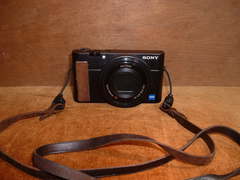
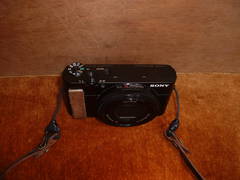
I used this while on a trip in Ukraine where it was 25-30 degrees and the double sided sticky tape didn't let go, I was pleasantly surprised by that.
For a fully manual camera that should give good pictures of beamshots I had narrowed my search early 2011, after having tried the WB2000 first, to either the Samsung EX1 or Olympus XZ-1 and choose the EX1.
After testing I found that the EX1 has a similar picture quality to the ST70 (sometimes the EX1 is slightly worse with JPG from the camera, more often better), full manual mode and a handy 2 or 10 second delay mode on dial (so this delay is done for each shot) which is perfect for beamshots.
To make a good video of a night ride is even more problematic than pictures, but the EX1 does a reasonable job giving usable nighttime vides of bicycle lamps (contrary to movies made with the ST70 and WB2000 that are far too dark and don't show much) that give a reasonable impression of the qualities of a bicycle lamp.
As a successor to the ST70 I thought about the WB2000 and EX1, and tried the WB2000 first as it's a lot smaller and lighter.
You can find in various places that less pixels at a given sensor size are better (less noise in the images), but the Samsung WB2000 (10M pixel) which is considered to be a very good camera gave me very much worse results than the Samsung ST70 (14 M pixel) at the same sensor size (1/2.3 inch). The following pictures, which were all taken with a tripod, will show this.
ST70:
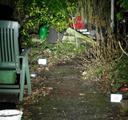
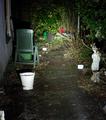
Original(s): st70-SAM_1059.jpg (5.4MB)
This is pretty big compared to the WB2000 jpegs, so prevent issues caused by jpeg compression I compressed the camera's jpeg to a much smaller 859 KB: st70-SAM_1059e.jpg (859 KB). This picture was used for the first 2 pictures.
WB2000:
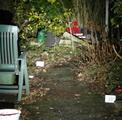
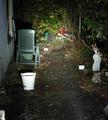
See how blurry the green at the rear is? How blurry the path is? (compared to the ST70) [ About focus with the WB2000 see also below ].
Original: wb2000-SAM_0001.jpg (1.7 MB)
Beamshot of an Edelux with the WB2000: Note how all the green stuff is blurred together and how you can't see the structure of the road very well. See all my other beamshots on this website for how much better the ST70 is...:
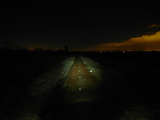
Focus and image stabilisation with the WB2000: I tried manual focus and automatic focus, I also experimented with image stabilisation (OIS) on and off and I just could not get good nighttime 4 second exposure images (compared to the Samsung ST70)...
A few tests in daylight didn't show much difference between ST70 and WB2000 for for example pictures of a bicycle headlamp, but pictures taken with flash of a box with some text on it showed the superiority of the ST70 compared to the WB2000: With the ST70 the text was still just legible, with the WB2000 it wasn't (this is not just from the higher resolution sensor of the ST70). I came across a comment somewhere that pictures from cameras with CMOS sensor are a bit softer than those with a CCD sensor. I hadn't seen that earlier, not before I bought the WB2000, and it seems to be correct in this case. Or if not, then I had a defective camera perhaps? It doesn't really matter I suppose, for videos the camera is certainly not good enough.
| To email me go to the email page |
Last modified: Sat Oct 26 05:11:58 CEST 2013